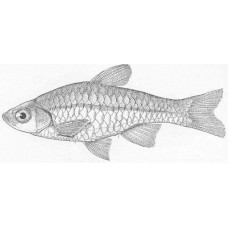Latin name
Rasbora philippina
Other names
Rasbora philippina
Identification
These fish have 12 scales between the back of the head and the back. The beginning of the dorsal scales is closer to the tail than to the snout. The lateral line extends completely to the caudal part; 9 rows of scales between the lateral lines above the middle of the caudal peduncle. The smallest depth of the caudal ramus is 1.44-1.77 cm long. The maxilla extends to the anterior margin of the eye.
Features of fish fins
Dorsal spines (total): 2; Dorsal soft rays (total): 7; Anal spines: 3; Anal soft rays: 5.
Fish colouring
Have a dark coloration on the back that changes to yellowish-white on the throat and belly. The scales are outlined with broad dark stripes or rows of dots. Fins are colorless with dark spots.
Distribution
Endemics Asia: Mindanao, Philippines.
Habitat
A tropical freshwater benthopelagic species.
Size
Maximum length: 6.5 cm.
Behavior
Coexists comfortably with most small peaceful fish and invertebrates.
Food and feeding habits
Micro-predators that feed on small insects, worms, crustaceans and other zooplankton.
Reproduction
Spawn without showing any parental concern for the offspring.
Fishing
Fished for sale to aquariums.
Relationship with a person
A species harmless to humans.
| Classification | |
| Phylum | Chordata |
| Class | Actinopterygii |
| Squad | Cypriniformes |
| Family | Cyprinidae |
| Genus | Rasbora |
| Species | R. philippina |
| Features | |
| Conservation status | Near Threatened |
| Habitat | Pelagic |
| Life span, years | No information |
| Maximum body weight, kg | No information |
| Maximum length, cm | 6,5 |
| Sailing speed, m/s | No information |
| Threat to people | Not edible |
| Way of eating | Predator |
Mindanao rasbora
Tags: mindanao rasbora

